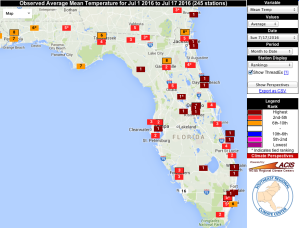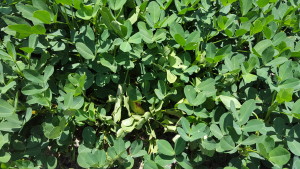Many have commented that 2016 feels like a warmer summer so far. They are not speaking in terms of a temporary heat wave, but a sustained long-term temperature increase. Monitoring stations in Florida show these observations are in fact correct. North Florida is about 2-3 degrees above normal for daily average temperature from July 1 to present. In our area, this sustained increase has led to the third warmest July on record. Much of the Florida peninsula is experiencing a record breaking July, on the heels of record high average temperatures in June.
Fortunately, rainfall has been a bit more widespread in the last two weeks in Columbia County. For crop farmers, the recent rainfall will help crop development. However, moist soils coupled with warm weather creates an excellent environment for plant diseases. High temperatures tend to increase growth of disease causing plant pathogens. Farmers are finding more symptoms of these diseases in their fields at this time. I felt like we were about 10-14 days early this year in terms of finding white mold in peanuts, as I began finding it about 21 days ago. We are finding disease signs and symptoms relatively easy now in farm fields.
We have had local discussions about the efficacy of products in the context of favorable disease environments such as we have now. We may have to get comfortable with not controlling disease, but simply doing our best to suppress it, if the environmental conditions continue to be an optimum for disease development. Although some years and conditions we see little yield variance in fungicide programs, white mold is a yield robber when left uncontrolled. We might be looking at a worst case scenario this time around, given the record setting temperatures, rainfall, and suitable conditions. We should continue to be vigilant making fungicide applications.



